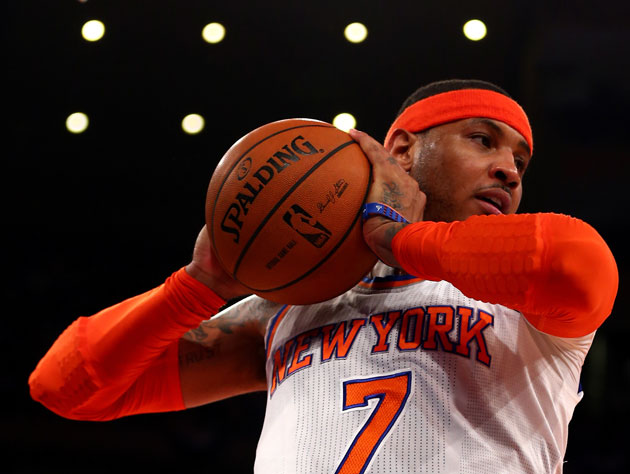
The Indiana Pacers are a poor offensive team, and yet they sprang out to a strong 3-1 lead in their Eastern semifinals matchup with the New York Knicks despite not setting the league ablaze with its offensive know-how. New York managed to keep their season alive in Thursday’s Game 5 win, though, mainly by deciding team-wise to not let this poor Indiana offensive team have chance after chance to showcase those poor offensive skills. Indiana dominated the Knicks in the offensive rebound department in the team’s three previous wins, and yet the Pacers were not allowed to be their typical, glass-cleaning selves on Thursday, leading to an impressive Knicks win.
The entertainment value of this contest was less than impressive. Though things settled down after a chippy start, both teams managed to keep their physical brand of ball on the level (though anyone on the other end of Kenyon Martin’s three fouls may disagree), and no tempers flared despite an aggressive, grimacing style of ball. That didn’t stop Raymond Felton’s ankle from going bust, though, or Lance Stephenson from taking several hard shots, and David West to nearly see his knee ligaments flash before his eyes after a fourth quarter collapse. Bodies were flying, and yet an Indiana team known for its league-best defense wasn’t the beneficiary.
Mainly because the Knicks stayed patient with their possessions. The team still moved quickly, whipping the ball around, but it also thought just as quickly when it came time to picking spots with jumpers. Players like Felton did fine work choosing when to fire the mid-range shot that Indiana doesn’t mind giving up, and even Carmelo Anthony’s isolation plays were of the forgivable variety – quick and successful post-ups against defenders like Paul George and Sam Young. Anthony finished his night with a passable 28 points on 28 shots. That isn’t to say there weren’t the usual array of questionable shots, but New York feeds off of that.
The Knicks, with their backs against the wall, earned this win. Still, the Pacers are going to be furious with themselves when they roll out of their ice baths on Friday and look at the game tape.
Indiana’s aggressive driving allowed for 33 free throws, but the Pacers only made 19 freebies on the night. And though point guard D.J. Augustin (starting in place of the injured George Hill) did fine work in nailing 3-7 three-pointers, overall he was a detriment. Augustin missed teammates in transition, he didn’t run the team’s half-court offense properly or react well to New York’s backcourt pressure, and his pick and roll defense on Felton was poor. It wasn’t a surprise to note that the game’s box score denied Indiana’s starting point guard of a single assist.
Hill’s absence was a major factor in this loss, but the Pacers also lost another significant key to its core between Games 4 and 5. Usually playoff rebounding champions that miss a combined 58 field goals and free throws in a game can reel in more than a dozen offensive rebounds, and yet the Knicks continually beat the Pacers to the punch on that end. Bereft of their second chances, the Pacers also had to deal with a Knick team that was now setting up its own offense in semi-transition. The Knicks didn’t remind anyone of the Showtime Lakers on Thursday, but that slight advantage as Indiana backpedaled was enough to throw a Pacer defense off-kilter just enough times to pull away.
Knicks coach Mike Woodson went with what for him was an off-kilter lineup in Tuesday’s Game 4, starting Kenyon Martin at power forward and going with an orthodox lineup that allowed the Pacers to bunch the middle and dominate the glass. The team’s return to a smaller starting lineup (with Martin out, and Pablo Prigoni back in) in Game 5 improved the team’s spacing, and the rotation reactions also put New York over. Chris Copeland was finally treated as a contributor worth treasuring, and he reacted by hitting 3-4 threes off the bench in 19 minutes, after playing just 31 minutes in the previous four games of the series.
Not all was fixed for New York. J.R. Smith’s 4-11 night was an improvement, but it speaks to his recent struggles from the floor that that sort of mark will be warmly reflected upon. And for the second straight game, Jason Kidd missed what was should have been an easy lay-up in transition, his go-to move for lo these many years. The Knicks have the veteran signed for lo these many two more years after this season, and he’s missed 21 of 24 shots in the postseason.
The Knicks are alive, though, and that’s all that matters. And with worries about George Hill and Lance Stephenson’s health and Indiana’s continued potential for ugly 15-point quarters, New York will go to Indiana and have a winnable Game 6 in front of them. If all goes right once again, they’ll play that deciding Game 7 with a frenzied Madison Square Garden on its side.
Even for all the Pacers’ mitigating factors, though, the Knicks had to play – let’s not call this a perfect game – but a focused Game 5 at home just to extend the season, and win by 10. And the Pacers still have those few hours of game tape to stew over.
Game 6 should be something else. It usually is, with these two teams.
No comments:
Post a Comment